ERM, Self-Organization, Networking, and Financial Performance
VerifiedAdded on 2021/02/21
|28
|11962
|45
Dissertation
AI Summary
This dissertation examines the impact of enterprise risk management (ERM), self-organization, and networking on financial performance within the context of Australian public procurement contracts. It begins with an introduction outlining the research topic, aims, objectives, and research questions, followed by a literature review that synthesizes existing academic work on the subject. The literature review delves into the importance of identifying and managing risks in a competitive business environment, highlighting the role of technology and tools like ERM. The dissertation also explores the relationship between ERM and financial performance, discussing various advantages and disadvantages of ERM implementation. The study aims to investigate the establishment of risk management processes and their effect on business performance, sustainable development, and good governance. The objectives include analyzing business capture policies, evaluating risk resilience, determining natural resource management, examining the relationship between public governance and private business development, and assessing government promotion of innovation through procurement. The research questions are designed to explore when and how business capture policy making, how businesses can play a role in building communities' risk resilience in the face of natural disaster, how management of natural resources such as forests, water etc. contribute to sustainable development, what is the relation between public governance and private business development, and how can governments promote innovations through procurement. The research significance lies in its potential to inform action and contextualize findings within a larger body of research, with implications for policy and future project implementation.
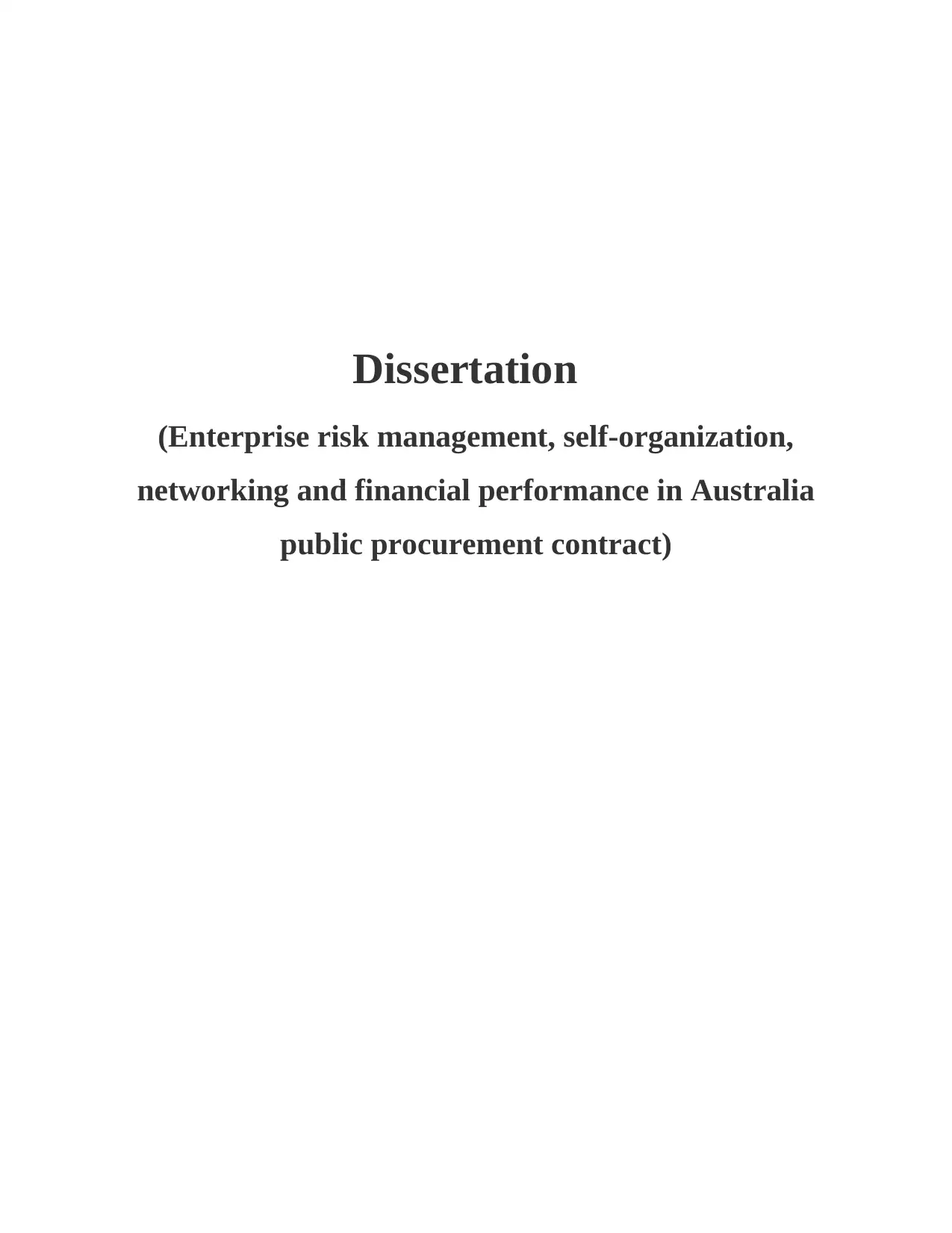
Dissertation
(Enterprise risk management, self-organization,
networking and financial performance in Australia
public procurement contract)
(Enterprise risk management, self-organization,
networking and financial performance in Australia
public procurement contract)
Paraphrase This Document
Need a fresh take? Get an instant paraphrase of this document with our AI Paraphraser

Table of Contents
BACKGROUND.............................................................................................................................3
AIMS AND OBJECTIVES.............................................................................................................3
REFERENCES..............................................................................................................................15
BACKGROUND.............................................................................................................................3
AIMS AND OBJECTIVES.............................................................................................................3
REFERENCES..............................................................................................................................15
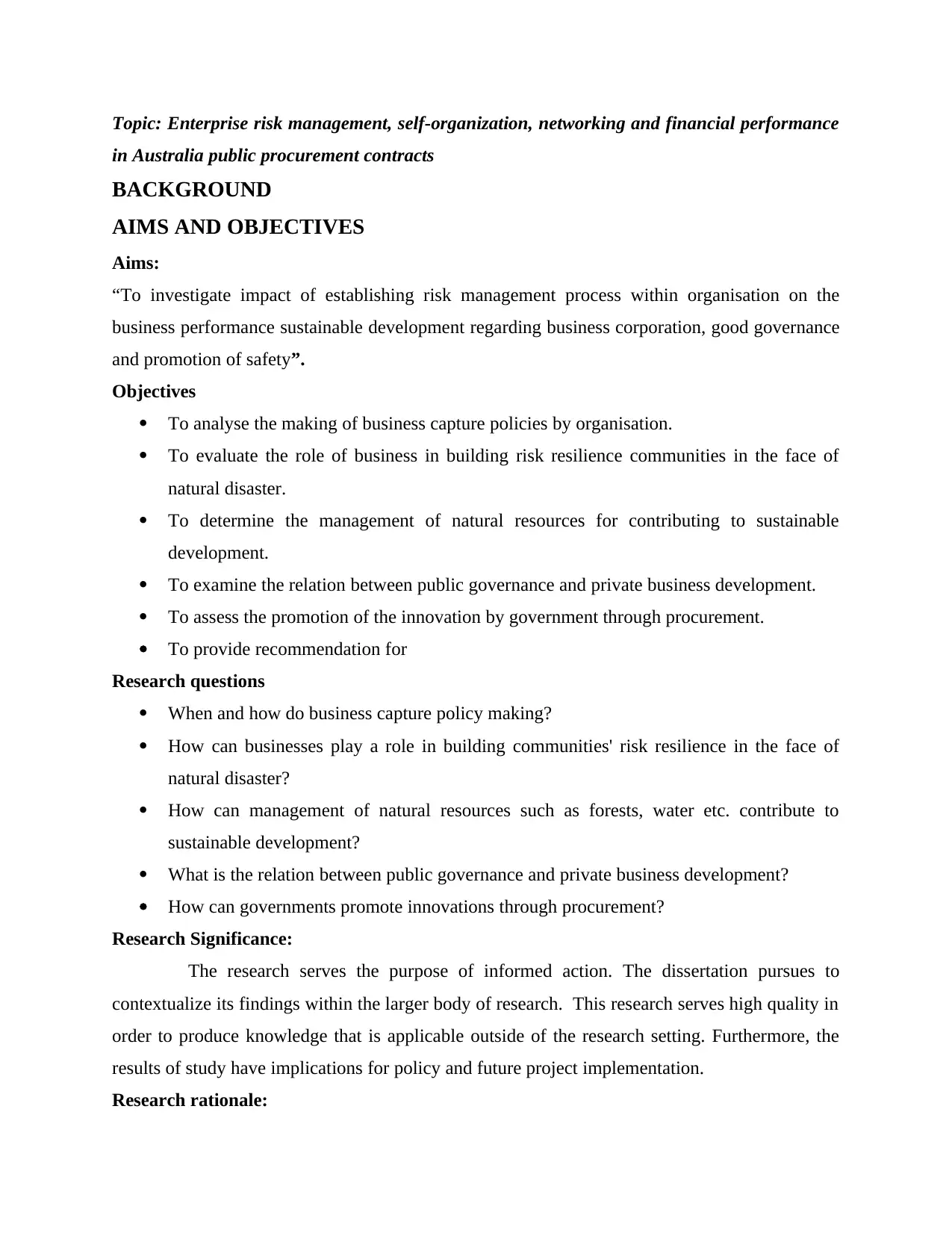
Topic: Enterprise risk management, self-organization, networking and financial performance
in Australia public procurement contracts
BACKGROUND
AIMS AND OBJECTIVES
Aims:
“To investigate impact of establishing risk management process within organisation on the
business performance sustainable development regarding business corporation, good governance
and promotion of safety”.
Objectives
To analyse the making of business capture policies by organisation.
To evaluate the role of business in building risk resilience communities in the face of
natural disaster.
To determine the management of natural resources for contributing to sustainable
development.
To examine the relation between public governance and private business development.
To assess the promotion of the innovation by government through procurement.
To provide recommendation for
Research questions
When and how do business capture policy making?
How can businesses play a role in building communities' risk resilience in the face of
natural disaster?
How can management of natural resources such as forests, water etc. contribute to
sustainable development?
What is the relation between public governance and private business development?
How can governments promote innovations through procurement?
Research Significance:
The research serves the purpose of informed action. The dissertation pursues to
contextualize its findings within the larger body of research. This research serves high quality in
order to produce knowledge that is applicable outside of the research setting. Furthermore, the
results of study have implications for policy and future project implementation.
Research rationale:
in Australia public procurement contracts
BACKGROUND
AIMS AND OBJECTIVES
Aims:
“To investigate impact of establishing risk management process within organisation on the
business performance sustainable development regarding business corporation, good governance
and promotion of safety”.
Objectives
To analyse the making of business capture policies by organisation.
To evaluate the role of business in building risk resilience communities in the face of
natural disaster.
To determine the management of natural resources for contributing to sustainable
development.
To examine the relation between public governance and private business development.
To assess the promotion of the innovation by government through procurement.
To provide recommendation for
Research questions
When and how do business capture policy making?
How can businesses play a role in building communities' risk resilience in the face of
natural disaster?
How can management of natural resources such as forests, water etc. contribute to
sustainable development?
What is the relation between public governance and private business development?
How can governments promote innovations through procurement?
Research Significance:
The research serves the purpose of informed action. The dissertation pursues to
contextualize its findings within the larger body of research. This research serves high quality in
order to produce knowledge that is applicable outside of the research setting. Furthermore, the
results of study have implications for policy and future project implementation.
Research rationale:
⊘ This is a preview!⊘
Do you want full access?
Subscribe today to unlock all pages.

Trusted by 1+ million students worldwide
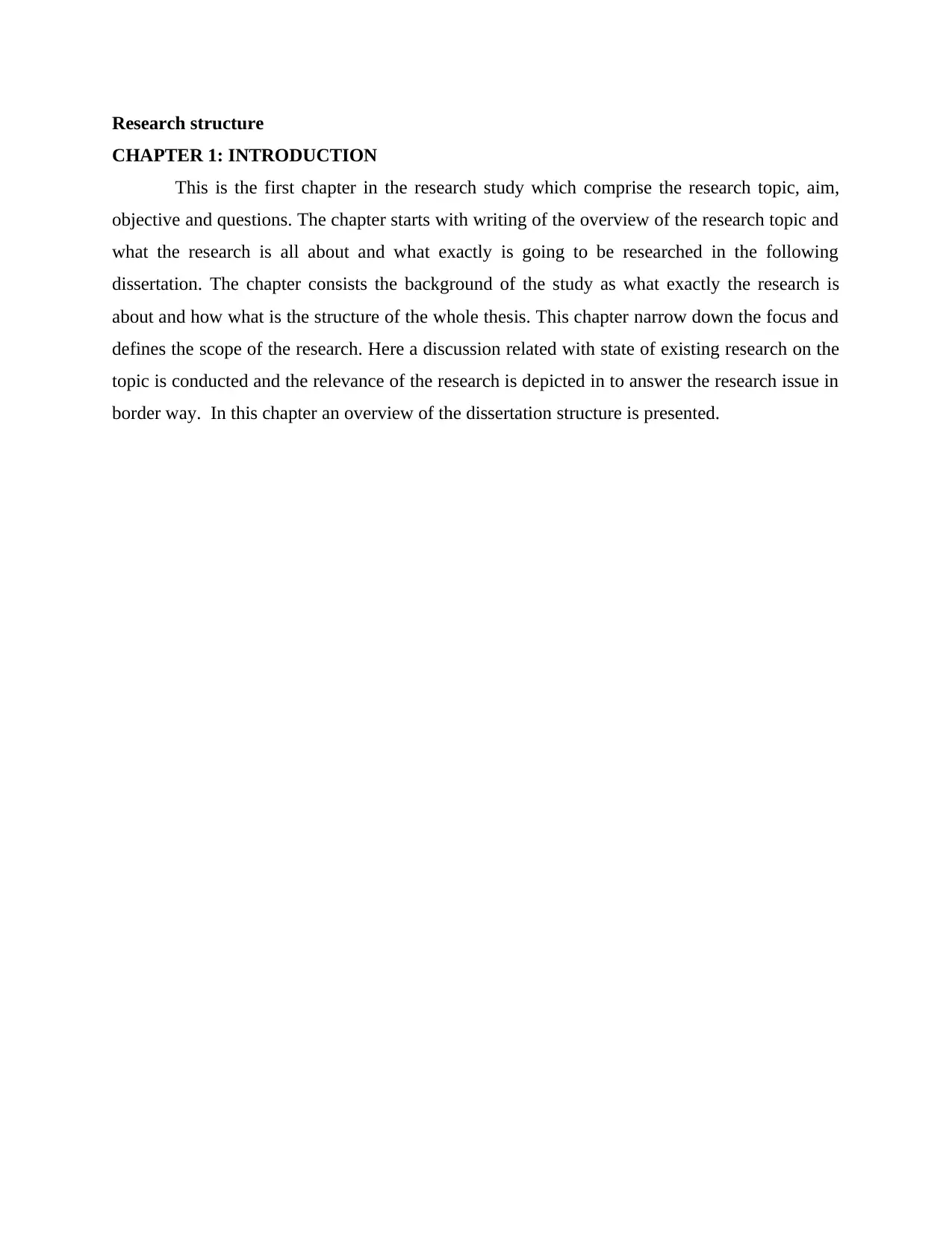
Research structure
CHAPTER 1: INTRODUCTION
This is the first chapter in the research study which comprise the research topic, aim,
objective and questions. The chapter starts with writing of the overview of the research topic and
what the research is all about and what exactly is going to be researched in the following
dissertation. The chapter consists the background of the study as what exactly the research is
about and how what is the structure of the whole thesis. This chapter narrow down the focus and
defines the scope of the research. Here a discussion related with state of existing research on the
topic is conducted and the relevance of the research is depicted in to answer the research issue in
border way. In this chapter an overview of the dissertation structure is presented.
CHAPTER 1: INTRODUCTION
This is the first chapter in the research study which comprise the research topic, aim,
objective and questions. The chapter starts with writing of the overview of the research topic and
what the research is all about and what exactly is going to be researched in the following
dissertation. The chapter consists the background of the study as what exactly the research is
about and how what is the structure of the whole thesis. This chapter narrow down the focus and
defines the scope of the research. Here a discussion related with state of existing research on the
topic is conducted and the relevance of the research is depicted in to answer the research issue in
border way. In this chapter an overview of the dissertation structure is presented.
Paraphrase This Document
Need a fresh take? Get an instant paraphrase of this document with our AI Paraphraser
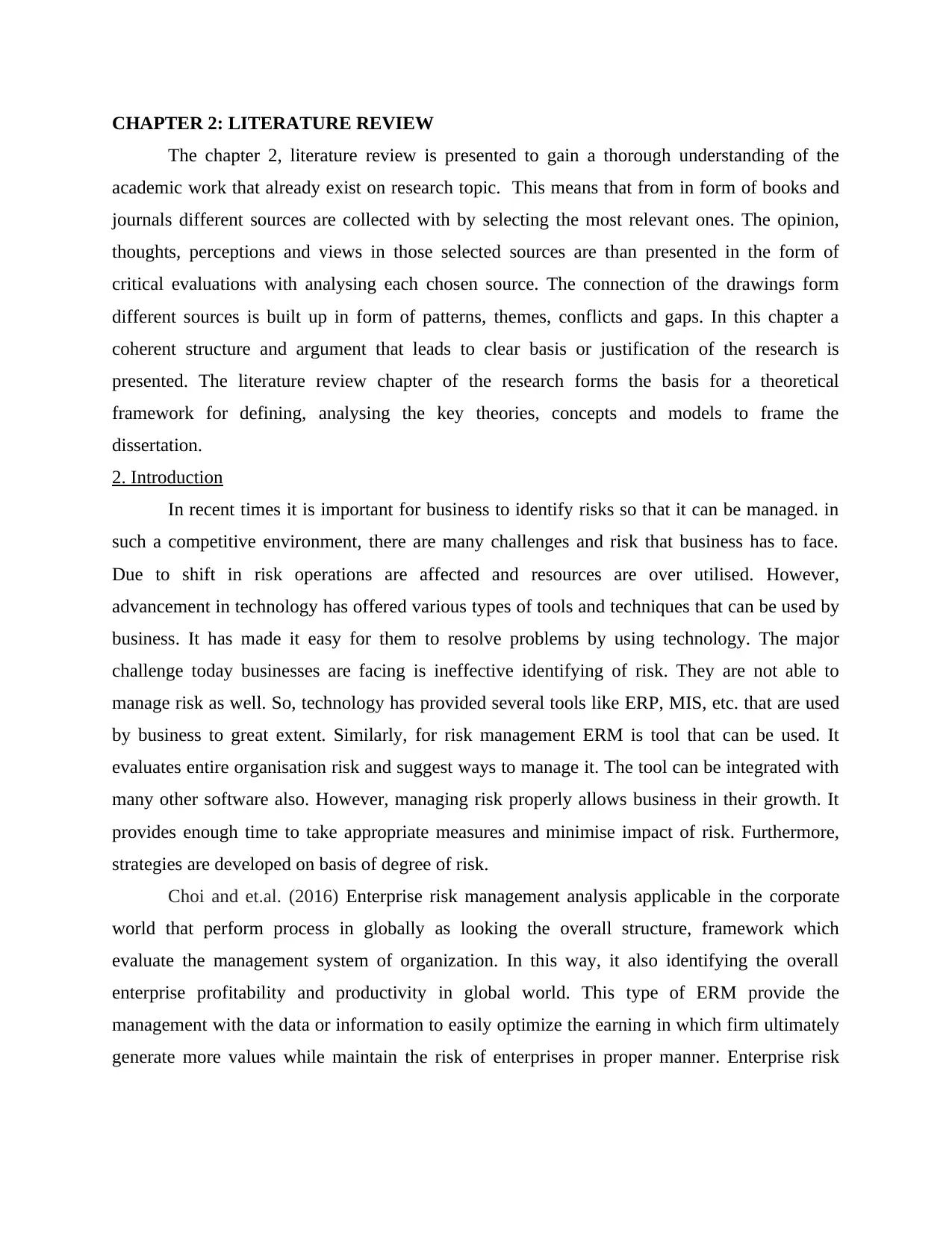
CHAPTER 2: LITERATURE REVIEW
The chapter 2, literature review is presented to gain a thorough understanding of the
academic work that already exist on research topic. This means that from in form of books and
journals different sources are collected with by selecting the most relevant ones. The opinion,
thoughts, perceptions and views in those selected sources are than presented in the form of
critical evaluations with analysing each chosen source. The connection of the drawings form
different sources is built up in form of patterns, themes, conflicts and gaps. In this chapter a
coherent structure and argument that leads to clear basis or justification of the research is
presented. The literature review chapter of the research forms the basis for a theoretical
framework for defining, analysing the key theories, concepts and models to frame the
dissertation.
2. Introduction
In recent times it is important for business to identify risks so that it can be managed. in
such a competitive environment, there are many challenges and risk that business has to face.
Due to shift in risk operations are affected and resources are over utilised. However,
advancement in technology has offered various types of tools and techniques that can be used by
business. It has made it easy for them to resolve problems by using technology. The major
challenge today businesses are facing is ineffective identifying of risk. They are not able to
manage risk as well. So, technology has provided several tools like ERP, MIS, etc. that are used
by business to great extent. Similarly, for risk management ERM is tool that can be used. It
evaluates entire organisation risk and suggest ways to manage it. The tool can be integrated with
many other software also. However, managing risk properly allows business in their growth. It
provides enough time to take appropriate measures and minimise impact of risk. Furthermore,
strategies are developed on basis of degree of risk.
Choi and et.al. (2016) Enterprise risk management analysis applicable in the corporate
world that perform process in globally as looking the overall structure, framework which
evaluate the management system of organization. In this way, it also identifying the overall
enterprise profitability and productivity in global world. This type of ERM provide the
management with the data or information to easily optimize the earning in which firm ultimately
generate more values while maintain the risk of enterprises in proper manner. Enterprise risk
The chapter 2, literature review is presented to gain a thorough understanding of the
academic work that already exist on research topic. This means that from in form of books and
journals different sources are collected with by selecting the most relevant ones. The opinion,
thoughts, perceptions and views in those selected sources are than presented in the form of
critical evaluations with analysing each chosen source. The connection of the drawings form
different sources is built up in form of patterns, themes, conflicts and gaps. In this chapter a
coherent structure and argument that leads to clear basis or justification of the research is
presented. The literature review chapter of the research forms the basis for a theoretical
framework for defining, analysing the key theories, concepts and models to frame the
dissertation.
2. Introduction
In recent times it is important for business to identify risks so that it can be managed. in
such a competitive environment, there are many challenges and risk that business has to face.
Due to shift in risk operations are affected and resources are over utilised. However,
advancement in technology has offered various types of tools and techniques that can be used by
business. It has made it easy for them to resolve problems by using technology. The major
challenge today businesses are facing is ineffective identifying of risk. They are not able to
manage risk as well. So, technology has provided several tools like ERP, MIS, etc. that are used
by business to great extent. Similarly, for risk management ERM is tool that can be used. It
evaluates entire organisation risk and suggest ways to manage it. The tool can be integrated with
many other software also. However, managing risk properly allows business in their growth. It
provides enough time to take appropriate measures and minimise impact of risk. Furthermore,
strategies are developed on basis of degree of risk.
Choi and et.al. (2016) Enterprise risk management analysis applicable in the corporate
world that perform process in globally as looking the overall structure, framework which
evaluate the management system of organization. In this way, it also identifying the overall
enterprise profitability and productivity in global world. This type of ERM provide the
management with the data or information to easily optimize the earning in which firm ultimately
generate more values while maintain the risk of enterprises in proper manner. Enterprise risk
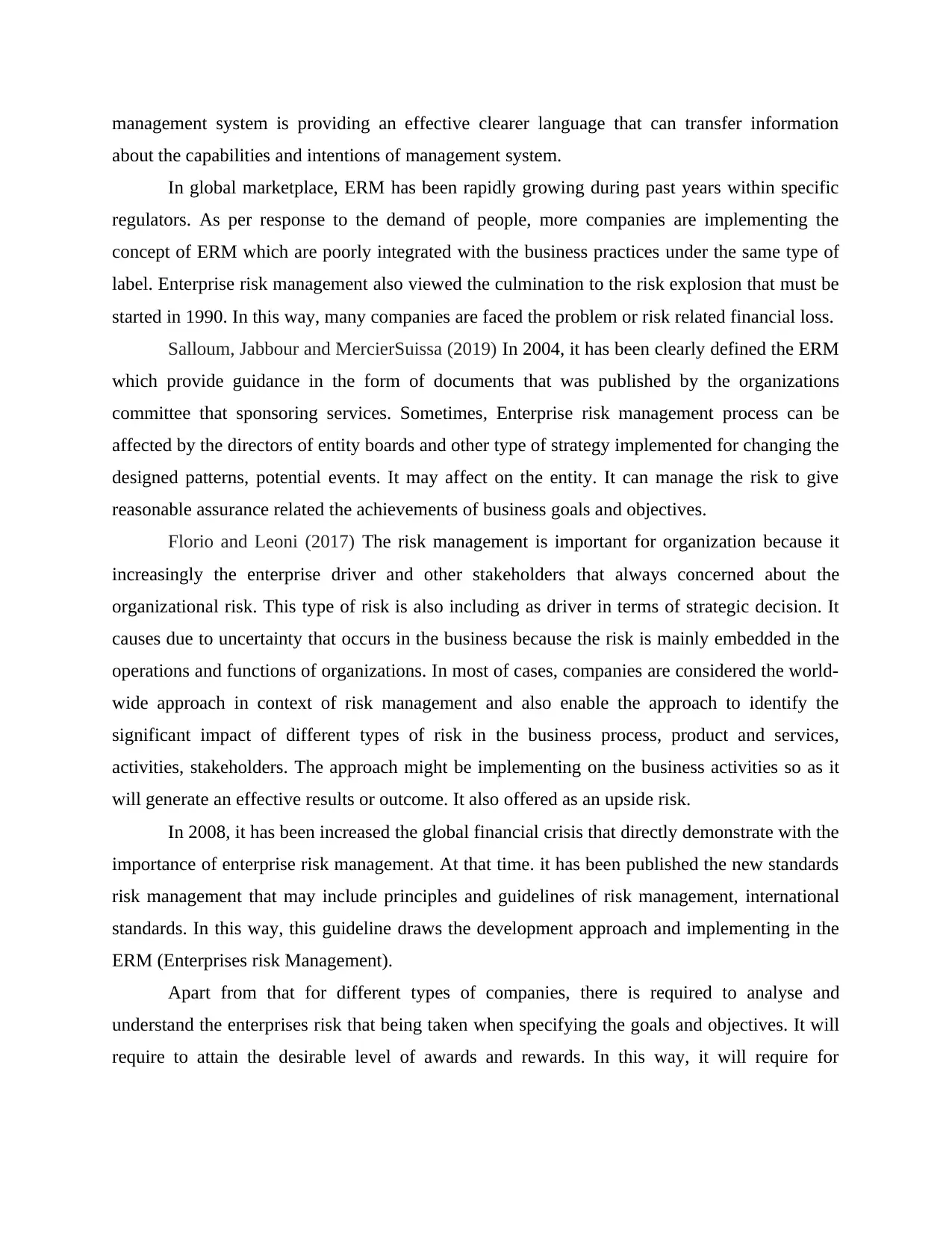
management system is providing an effective clearer language that can transfer information
about the capabilities and intentions of management system.
In global marketplace, ERM has been rapidly growing during past years within specific
regulators. As per response to the demand of people, more companies are implementing the
concept of ERM which are poorly integrated with the business practices under the same type of
label. Enterprise risk management also viewed the culmination to the risk explosion that must be
started in 1990. In this way, many companies are faced the problem or risk related financial loss.
Salloum, Jabbour and MercierSuissa (2019) In 2004, it has been clearly defined the ERM
which provide guidance in the form of documents that was published by the organizations
committee that sponsoring services. Sometimes, Enterprise risk management process can be
affected by the directors of entity boards and other type of strategy implemented for changing the
designed patterns, potential events. It may affect on the entity. It can manage the risk to give
reasonable assurance related the achievements of business goals and objectives.
Florio and Leoni (2017) The risk management is important for organization because it
increasingly the enterprise driver and other stakeholders that always concerned about the
organizational risk. This type of risk is also including as driver in terms of strategic decision. It
causes due to uncertainty that occurs in the business because the risk is mainly embedded in the
operations and functions of organizations. In most of cases, companies are considered the world-
wide approach in context of risk management and also enable the approach to identify the
significant impact of different types of risk in the business process, product and services,
activities, stakeholders. The approach might be implementing on the business activities so as it
will generate an effective results or outcome. It also offered as an upside risk.
In 2008, it has been increased the global financial crisis that directly demonstrate with the
importance of enterprise risk management. At that time. it has been published the new standards
risk management that may include principles and guidelines of risk management, international
standards. In this way, this guideline draws the development approach and implementing in the
ERM (Enterprises risk Management).
Apart from that for different types of companies, there is required to analyse and
understand the enterprises risk that being taken when specifying the goals and objectives. It will
require to attain the desirable level of awards and rewards. In this way, it will require for
about the capabilities and intentions of management system.
In global marketplace, ERM has been rapidly growing during past years within specific
regulators. As per response to the demand of people, more companies are implementing the
concept of ERM which are poorly integrated with the business practices under the same type of
label. Enterprise risk management also viewed the culmination to the risk explosion that must be
started in 1990. In this way, many companies are faced the problem or risk related financial loss.
Salloum, Jabbour and MercierSuissa (2019) In 2004, it has been clearly defined the ERM
which provide guidance in the form of documents that was published by the organizations
committee that sponsoring services. Sometimes, Enterprise risk management process can be
affected by the directors of entity boards and other type of strategy implemented for changing the
designed patterns, potential events. It may affect on the entity. It can manage the risk to give
reasonable assurance related the achievements of business goals and objectives.
Florio and Leoni (2017) The risk management is important for organization because it
increasingly the enterprise driver and other stakeholders that always concerned about the
organizational risk. This type of risk is also including as driver in terms of strategic decision. It
causes due to uncertainty that occurs in the business because the risk is mainly embedded in the
operations and functions of organizations. In most of cases, companies are considered the world-
wide approach in context of risk management and also enable the approach to identify the
significant impact of different types of risk in the business process, product and services,
activities, stakeholders. The approach might be implementing on the business activities so as it
will generate an effective results or outcome. It also offered as an upside risk.
In 2008, it has been increased the global financial crisis that directly demonstrate with the
importance of enterprise risk management. At that time. it has been published the new standards
risk management that may include principles and guidelines of risk management, international
standards. In this way, this guideline draws the development approach and implementing in the
ERM (Enterprises risk Management).
Apart from that for different types of companies, there is required to analyse and
understand the enterprises risk that being taken when specifying the goals and objectives. It will
require to attain the desirable level of awards and rewards. In this way, it will require for
⊘ This is a preview!⊘
Do you want full access?
Subscribe today to unlock all pages.

Trusted by 1+ million students worldwide
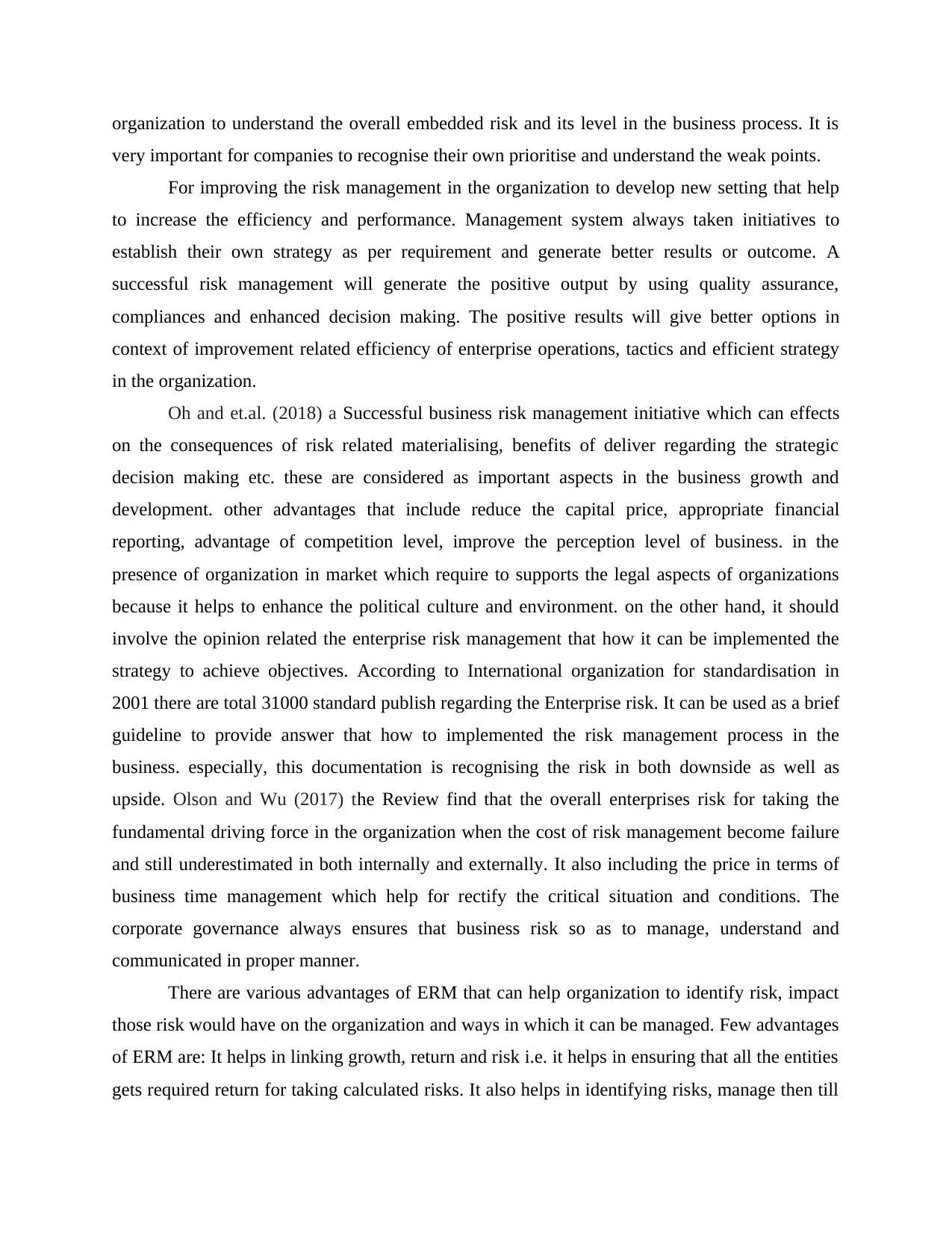
organization to understand the overall embedded risk and its level in the business process. It is
very important for companies to recognise their own prioritise and understand the weak points.
For improving the risk management in the organization to develop new setting that help
to increase the efficiency and performance. Management system always taken initiatives to
establish their own strategy as per requirement and generate better results or outcome. A
successful risk management will generate the positive output by using quality assurance,
compliances and enhanced decision making. The positive results will give better options in
context of improvement related efficiency of enterprise operations, tactics and efficient strategy
in the organization.
Oh and et.al. (2018) a Successful business risk management initiative which can effects
on the consequences of risk related materialising, benefits of deliver regarding the strategic
decision making etc. these are considered as important aspects in the business growth and
development. other advantages that include reduce the capital price, appropriate financial
reporting, advantage of competition level, improve the perception level of business. in the
presence of organization in market which require to supports the legal aspects of organizations
because it helps to enhance the political culture and environment. on the other hand, it should
involve the opinion related the enterprise risk management that how it can be implemented the
strategy to achieve objectives. According to International organization for standardisation in
2001 there are total 31000 standard publish regarding the Enterprise risk. It can be used as a brief
guideline to provide answer that how to implemented the risk management process in the
business. especially, this documentation is recognising the risk in both downside as well as
upside. Olson and Wu (2017) the Review find that the overall enterprises risk for taking the
fundamental driving force in the organization when the cost of risk management become failure
and still underestimated in both internally and externally. It also including the price in terms of
business time management which help for rectify the critical situation and conditions. The
corporate governance always ensures that business risk so as to manage, understand and
communicated in proper manner.
There are various advantages of ERM that can help organization to identify risk, impact
those risk would have on the organization and ways in which it can be managed. Few advantages
of ERM are: It helps in linking growth, return and risk i.e. it helps in ensuring that all the entities
gets required return for taking calculated risks. It also helps in identifying risks, manage then till
very important for companies to recognise their own prioritise and understand the weak points.
For improving the risk management in the organization to develop new setting that help
to increase the efficiency and performance. Management system always taken initiatives to
establish their own strategy as per requirement and generate better results or outcome. A
successful risk management will generate the positive output by using quality assurance,
compliances and enhanced decision making. The positive results will give better options in
context of improvement related efficiency of enterprise operations, tactics and efficient strategy
in the organization.
Oh and et.al. (2018) a Successful business risk management initiative which can effects
on the consequences of risk related materialising, benefits of deliver regarding the strategic
decision making etc. these are considered as important aspects in the business growth and
development. other advantages that include reduce the capital price, appropriate financial
reporting, advantage of competition level, improve the perception level of business. in the
presence of organization in market which require to supports the legal aspects of organizations
because it helps to enhance the political culture and environment. on the other hand, it should
involve the opinion related the enterprise risk management that how it can be implemented the
strategy to achieve objectives. According to International organization for standardisation in
2001 there are total 31000 standard publish regarding the Enterprise risk. It can be used as a brief
guideline to provide answer that how to implemented the risk management process in the
business. especially, this documentation is recognising the risk in both downside as well as
upside. Olson and Wu (2017) the Review find that the overall enterprises risk for taking the
fundamental driving force in the organization when the cost of risk management become failure
and still underestimated in both internally and externally. It also including the price in terms of
business time management which help for rectify the critical situation and conditions. The
corporate governance always ensures that business risk so as to manage, understand and
communicated in proper manner.
There are various advantages of ERM that can help organization to identify risk, impact
those risk would have on the organization and ways in which it can be managed. Few advantages
of ERM are: It helps in linking growth, return and risk i.e. it helps in ensuring that all the entities
gets required return for taking calculated risks. It also helps in identifying risks, manage then till
Paraphrase This Document
Need a fresh take? Get an instant paraphrase of this document with our AI Paraphraser
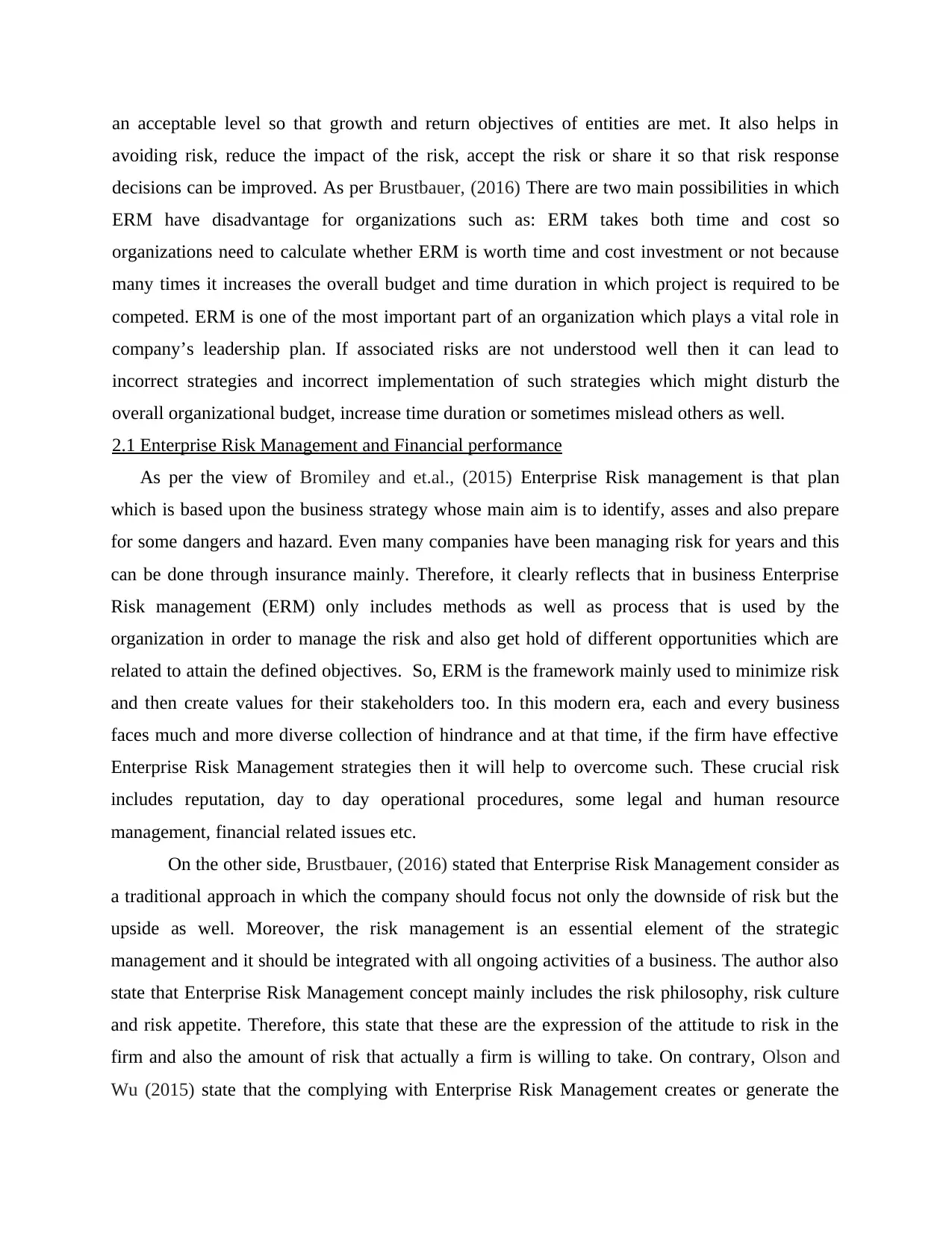
an acceptable level so that growth and return objectives of entities are met. It also helps in
avoiding risk, reduce the impact of the risk, accept the risk or share it so that risk response
decisions can be improved. As per Brustbauer, (2016) There are two main possibilities in which
ERM have disadvantage for organizations such as: ERM takes both time and cost so
organizations need to calculate whether ERM is worth time and cost investment or not because
many times it increases the overall budget and time duration in which project is required to be
competed. ERM is one of the most important part of an organization which plays a vital role in
company’s leadership plan. If associated risks are not understood well then it can lead to
incorrect strategies and incorrect implementation of such strategies which might disturb the
overall organizational budget, increase time duration or sometimes mislead others as well.
2.1 Enterprise Risk Management and Financial performance
As per the view of Bromiley and et.al., (2015) Enterprise Risk management is that plan
which is based upon the business strategy whose main aim is to identify, asses and also prepare
for some dangers and hazard. Even many companies have been managing risk for years and this
can be done through insurance mainly. Therefore, it clearly reflects that in business Enterprise
Risk management (ERM) only includes methods as well as process that is used by the
organization in order to manage the risk and also get hold of different opportunities which are
related to attain the defined objectives. So, ERM is the framework mainly used to minimize risk
and then create values for their stakeholders too. In this modern era, each and every business
faces much and more diverse collection of hindrance and at that time, if the firm have effective
Enterprise Risk Management strategies then it will help to overcome such. These crucial risk
includes reputation, day to day operational procedures, some legal and human resource
management, financial related issues etc.
On the other side, Brustbauer, (2016) stated that Enterprise Risk Management consider as
a traditional approach in which the company should focus not only the downside of risk but the
upside as well. Moreover, the risk management is an essential element of the strategic
management and it should be integrated with all ongoing activities of a business. The author also
state that Enterprise Risk Management concept mainly includes the risk philosophy, risk culture
and risk appetite. Therefore, this state that these are the expression of the attitude to risk in the
firm and also the amount of risk that actually a firm is willing to take. On contrary, Olson and
Wu (2015) state that the complying with Enterprise Risk Management creates or generate the
avoiding risk, reduce the impact of the risk, accept the risk or share it so that risk response
decisions can be improved. As per Brustbauer, (2016) There are two main possibilities in which
ERM have disadvantage for organizations such as: ERM takes both time and cost so
organizations need to calculate whether ERM is worth time and cost investment or not because
many times it increases the overall budget and time duration in which project is required to be
competed. ERM is one of the most important part of an organization which plays a vital role in
company’s leadership plan. If associated risks are not understood well then it can lead to
incorrect strategies and incorrect implementation of such strategies which might disturb the
overall organizational budget, increase time duration or sometimes mislead others as well.
2.1 Enterprise Risk Management and Financial performance
As per the view of Bromiley and et.al., (2015) Enterprise Risk management is that plan
which is based upon the business strategy whose main aim is to identify, asses and also prepare
for some dangers and hazard. Even many companies have been managing risk for years and this
can be done through insurance mainly. Therefore, it clearly reflects that in business Enterprise
Risk management (ERM) only includes methods as well as process that is used by the
organization in order to manage the risk and also get hold of different opportunities which are
related to attain the defined objectives. So, ERM is the framework mainly used to minimize risk
and then create values for their stakeholders too. In this modern era, each and every business
faces much and more diverse collection of hindrance and at that time, if the firm have effective
Enterprise Risk Management strategies then it will help to overcome such. These crucial risk
includes reputation, day to day operational procedures, some legal and human resource
management, financial related issues etc.
On the other side, Brustbauer, (2016) stated that Enterprise Risk Management consider as
a traditional approach in which the company should focus not only the downside of risk but the
upside as well. Moreover, the risk management is an essential element of the strategic
management and it should be integrated with all ongoing activities of a business. The author also
state that Enterprise Risk Management concept mainly includes the risk philosophy, risk culture
and risk appetite. Therefore, this state that these are the expression of the attitude to risk in the
firm and also the amount of risk that actually a firm is willing to take. On contrary, Olson and
Wu (2015) state that the complying with Enterprise Risk Management creates or generate the
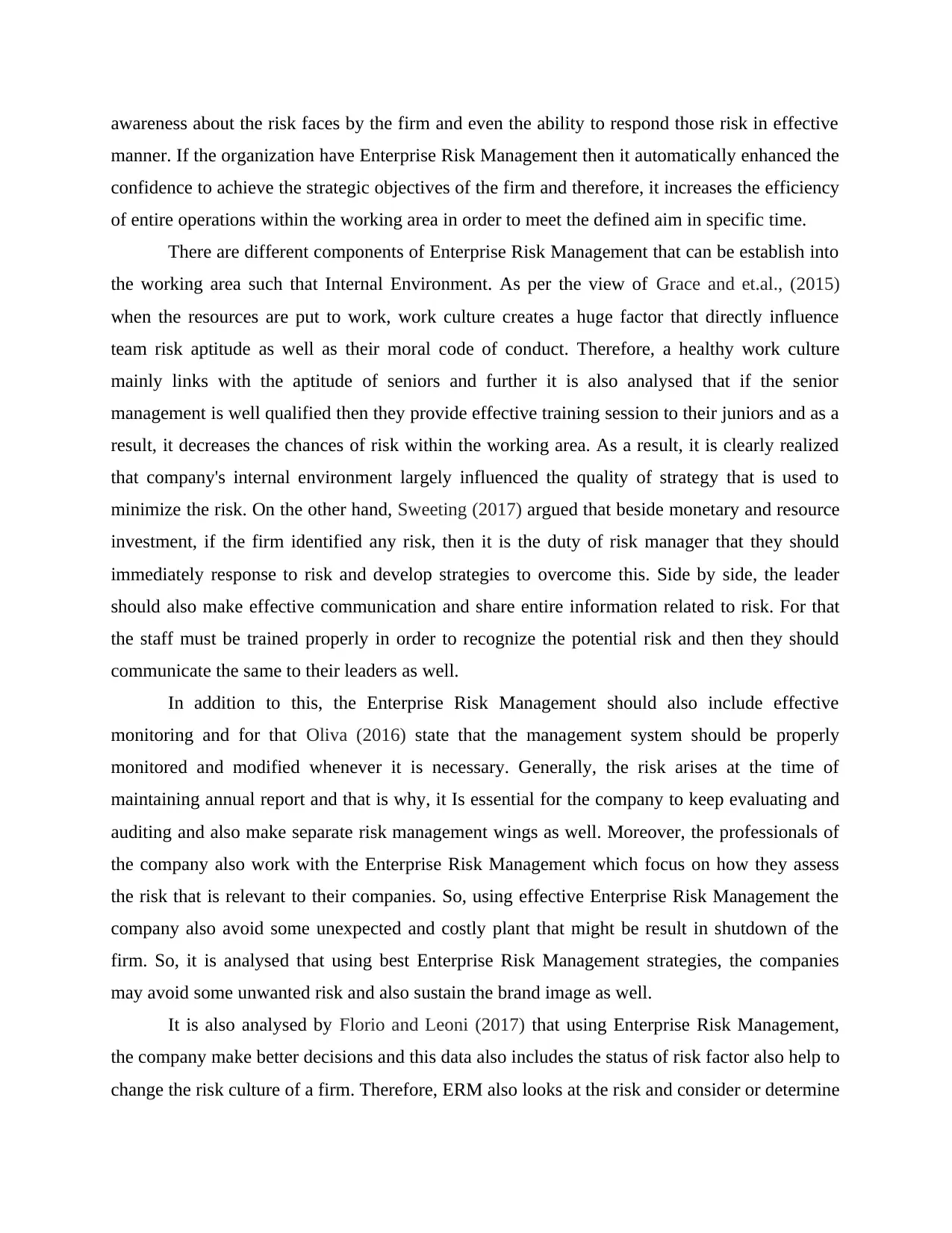
awareness about the risk faces by the firm and even the ability to respond those risk in effective
manner. If the organization have Enterprise Risk Management then it automatically enhanced the
confidence to achieve the strategic objectives of the firm and therefore, it increases the efficiency
of entire operations within the working area in order to meet the defined aim in specific time.
There are different components of Enterprise Risk Management that can be establish into
the working area such that Internal Environment. As per the view of Grace and et.al., (2015)
when the resources are put to work, work culture creates a huge factor that directly influence
team risk aptitude as well as their moral code of conduct. Therefore, a healthy work culture
mainly links with the aptitude of seniors and further it is also analysed that if the senior
management is well qualified then they provide effective training session to their juniors and as a
result, it decreases the chances of risk within the working area. As a result, it is clearly realized
that company's internal environment largely influenced the quality of strategy that is used to
minimize the risk. On the other hand, Sweeting (2017) argued that beside monetary and resource
investment, if the firm identified any risk, then it is the duty of risk manager that they should
immediately response to risk and develop strategies to overcome this. Side by side, the leader
should also make effective communication and share entire information related to risk. For that
the staff must be trained properly in order to recognize the potential risk and then they should
communicate the same to their leaders as well.
In addition to this, the Enterprise Risk Management should also include effective
monitoring and for that Oliva (2016) state that the management system should be properly
monitored and modified whenever it is necessary. Generally, the risk arises at the time of
maintaining annual report and that is why, it Is essential for the company to keep evaluating and
auditing and also make separate risk management wings as well. Moreover, the professionals of
the company also work with the Enterprise Risk Management which focus on how they assess
the risk that is relevant to their companies. So, using effective Enterprise Risk Management the
company also avoid some unexpected and costly plant that might be result in shutdown of the
firm. So, it is analysed that using best Enterprise Risk Management strategies, the companies
may avoid some unwanted risk and also sustain the brand image as well.
It is also analysed by Florio and Leoni (2017) that using Enterprise Risk Management,
the company make better decisions and this data also includes the status of risk factor also help to
change the risk culture of a firm. Therefore, ERM also looks at the risk and consider or determine
manner. If the organization have Enterprise Risk Management then it automatically enhanced the
confidence to achieve the strategic objectives of the firm and therefore, it increases the efficiency
of entire operations within the working area in order to meet the defined aim in specific time.
There are different components of Enterprise Risk Management that can be establish into
the working area such that Internal Environment. As per the view of Grace and et.al., (2015)
when the resources are put to work, work culture creates a huge factor that directly influence
team risk aptitude as well as their moral code of conduct. Therefore, a healthy work culture
mainly links with the aptitude of seniors and further it is also analysed that if the senior
management is well qualified then they provide effective training session to their juniors and as a
result, it decreases the chances of risk within the working area. As a result, it is clearly realized
that company's internal environment largely influenced the quality of strategy that is used to
minimize the risk. On the other hand, Sweeting (2017) argued that beside monetary and resource
investment, if the firm identified any risk, then it is the duty of risk manager that they should
immediately response to risk and develop strategies to overcome this. Side by side, the leader
should also make effective communication and share entire information related to risk. For that
the staff must be trained properly in order to recognize the potential risk and then they should
communicate the same to their leaders as well.
In addition to this, the Enterprise Risk Management should also include effective
monitoring and for that Oliva (2016) state that the management system should be properly
monitored and modified whenever it is necessary. Generally, the risk arises at the time of
maintaining annual report and that is why, it Is essential for the company to keep evaluating and
auditing and also make separate risk management wings as well. Moreover, the professionals of
the company also work with the Enterprise Risk Management which focus on how they assess
the risk that is relevant to their companies. So, using effective Enterprise Risk Management the
company also avoid some unexpected and costly plant that might be result in shutdown of the
firm. So, it is analysed that using best Enterprise Risk Management strategies, the companies
may avoid some unwanted risk and also sustain the brand image as well.
It is also analysed by Florio and Leoni (2017) that using Enterprise Risk Management,
the company make better decisions and this data also includes the status of risk factor also help to
change the risk culture of a firm. Therefore, ERM also looks at the risk and consider or determine
⊘ This is a preview!⊘
Do you want full access?
Subscribe today to unlock all pages.

Trusted by 1+ million students worldwide
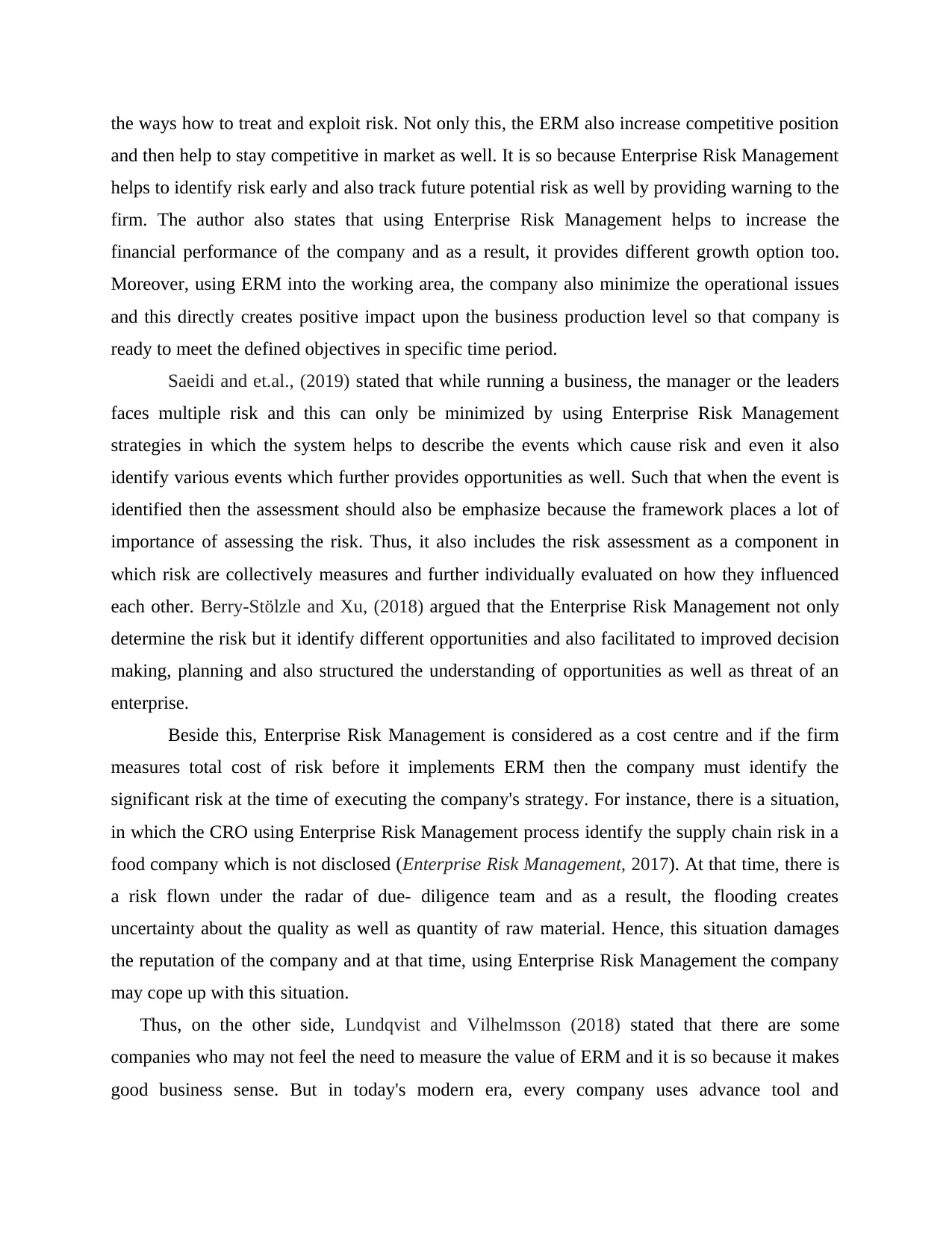
the ways how to treat and exploit risk. Not only this, the ERM also increase competitive position
and then help to stay competitive in market as well. It is so because Enterprise Risk Management
helps to identify risk early and also track future potential risk as well by providing warning to the
firm. The author also states that using Enterprise Risk Management helps to increase the
financial performance of the company and as a result, it provides different growth option too.
Moreover, using ERM into the working area, the company also minimize the operational issues
and this directly creates positive impact upon the business production level so that company is
ready to meet the defined objectives in specific time period.
Saeidi and et.al., (2019) stated that while running a business, the manager or the leaders
faces multiple risk and this can only be minimized by using Enterprise Risk Management
strategies in which the system helps to describe the events which cause risk and even it also
identify various events which further provides opportunities as well. Such that when the event is
identified then the assessment should also be emphasize because the framework places a lot of
importance of assessing the risk. Thus, it also includes the risk assessment as a component in
which risk are collectively measures and further individually evaluated on how they influenced
each other. Berry‐Stölzle and Xu, (2018) argued that the Enterprise Risk Management not only
determine the risk but it identify different opportunities and also facilitated to improved decision
making, planning and also structured the understanding of opportunities as well as threat of an
enterprise.
Beside this, Enterprise Risk Management is considered as a cost centre and if the firm
measures total cost of risk before it implements ERM then the company must identify the
significant risk at the time of executing the company's strategy. For instance, there is a situation,
in which the CRO using Enterprise Risk Management process identify the supply chain risk in a
food company which is not disclosed (Enterprise Risk Management, 2017). At that time, there is
a risk flown under the radar of due- diligence team and as a result, the flooding creates
uncertainty about the quality as well as quantity of raw material. Hence, this situation damages
the reputation of the company and at that time, using Enterprise Risk Management the company
may cope up with this situation.
Thus, on the other side, Lundqvist and Vilhelmsson (2018) stated that there are some
companies who may not feel the need to measure the value of ERM and it is so because it makes
good business sense. But in today's modern era, every company uses advance tool and
and then help to stay competitive in market as well. It is so because Enterprise Risk Management
helps to identify risk early and also track future potential risk as well by providing warning to the
firm. The author also states that using Enterprise Risk Management helps to increase the
financial performance of the company and as a result, it provides different growth option too.
Moreover, using ERM into the working area, the company also minimize the operational issues
and this directly creates positive impact upon the business production level so that company is
ready to meet the defined objectives in specific time period.
Saeidi and et.al., (2019) stated that while running a business, the manager or the leaders
faces multiple risk and this can only be minimized by using Enterprise Risk Management
strategies in which the system helps to describe the events which cause risk and even it also
identify various events which further provides opportunities as well. Such that when the event is
identified then the assessment should also be emphasize because the framework places a lot of
importance of assessing the risk. Thus, it also includes the risk assessment as a component in
which risk are collectively measures and further individually evaluated on how they influenced
each other. Berry‐Stölzle and Xu, (2018) argued that the Enterprise Risk Management not only
determine the risk but it identify different opportunities and also facilitated to improved decision
making, planning and also structured the understanding of opportunities as well as threat of an
enterprise.
Beside this, Enterprise Risk Management is considered as a cost centre and if the firm
measures total cost of risk before it implements ERM then the company must identify the
significant risk at the time of executing the company's strategy. For instance, there is a situation,
in which the CRO using Enterprise Risk Management process identify the supply chain risk in a
food company which is not disclosed (Enterprise Risk Management, 2017). At that time, there is
a risk flown under the radar of due- diligence team and as a result, the flooding creates
uncertainty about the quality as well as quantity of raw material. Hence, this situation damages
the reputation of the company and at that time, using Enterprise Risk Management the company
may cope up with this situation.
Thus, on the other side, Lundqvist and Vilhelmsson (2018) stated that there are some
companies who may not feel the need to measure the value of ERM and it is so because it makes
good business sense. But in today's modern era, every company uses advance tool and
Paraphrase This Document
Need a fresh take? Get an instant paraphrase of this document with our AI Paraphraser
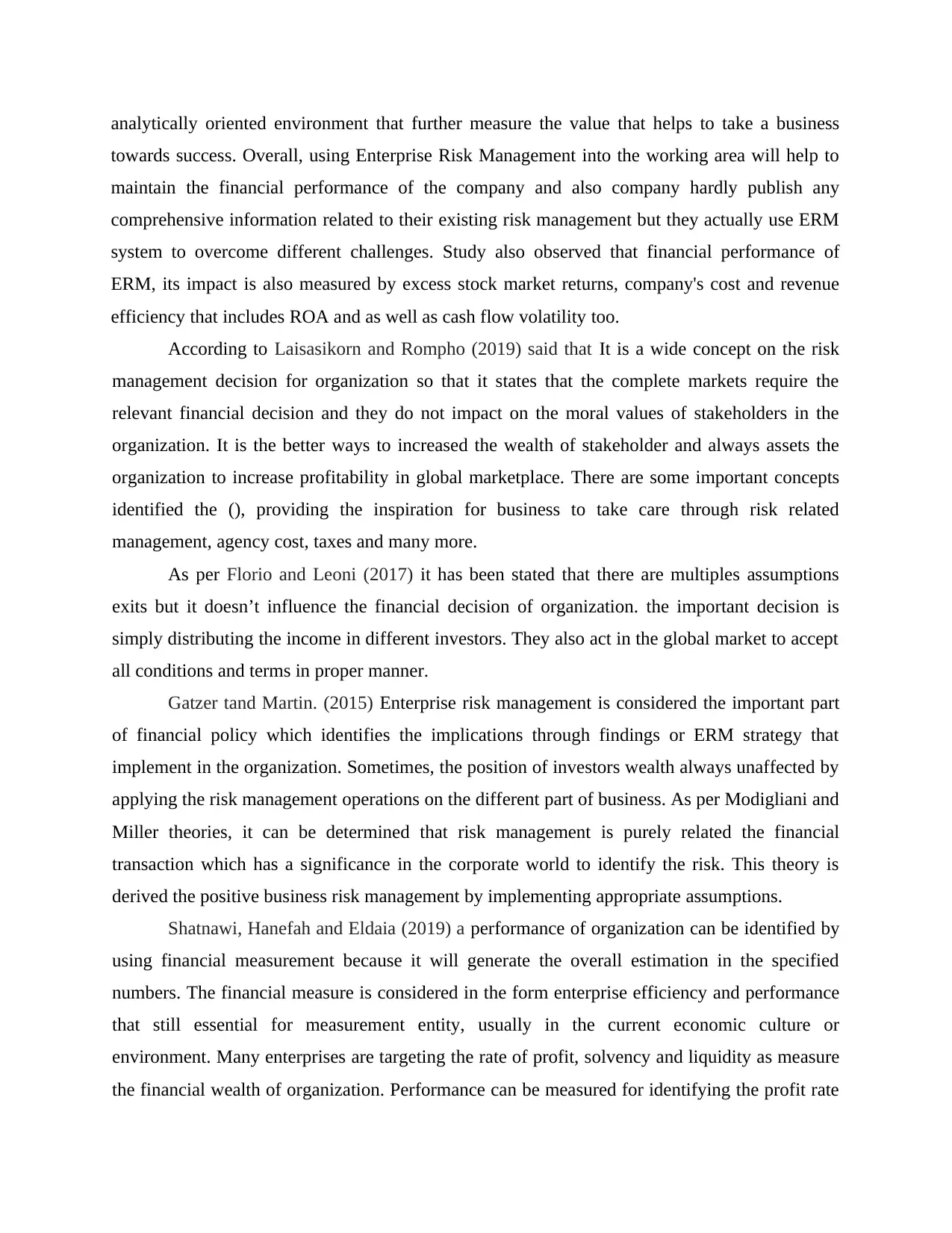
analytically oriented environment that further measure the value that helps to take a business
towards success. Overall, using Enterprise Risk Management into the working area will help to
maintain the financial performance of the company and also company hardly publish any
comprehensive information related to their existing risk management but they actually use ERM
system to overcome different challenges. Study also observed that financial performance of
ERM, its impact is also measured by excess stock market returns, company's cost and revenue
efficiency that includes ROA and as well as cash flow volatility too.
According to Laisasikorn and Rompho (2019) said that It is a wide concept on the risk
management decision for organization so that it states that the complete markets require the
relevant financial decision and they do not impact on the moral values of stakeholders in the
organization. It is the better ways to increased the wealth of stakeholder and always assets the
organization to increase profitability in global marketplace. There are some important concepts
identified the (), providing the inspiration for business to take care through risk related
management, agency cost, taxes and many more.
As per Florio and Leoni (2017) it has been stated that there are multiples assumptions
exits but it doesn’t influence the financial decision of organization. the important decision is
simply distributing the income in different investors. They also act in the global market to accept
all conditions and terms in proper manner.
Gatzer tand Martin. (2015) Enterprise risk management is considered the important part
of financial policy which identifies the implications through findings or ERM strategy that
implement in the organization. Sometimes, the position of investors wealth always unaffected by
applying the risk management operations on the different part of business. As per Modigliani and
Miller theories, it can be determined that risk management is purely related the financial
transaction which has a significance in the corporate world to identify the risk. This theory is
derived the positive business risk management by implementing appropriate assumptions.
Shatnawi, Hanefah and Eldaia (2019) a performance of organization can be identified by
using financial measurement because it will generate the overall estimation in the specified
numbers. The financial measure is considered in the form enterprise efficiency and performance
that still essential for measurement entity, usually in the current economic culture or
environment. Many enterprises are targeting the rate of profit, solvency and liquidity as measure
the financial wealth of organization. Performance can be measured for identifying the profit rate
towards success. Overall, using Enterprise Risk Management into the working area will help to
maintain the financial performance of the company and also company hardly publish any
comprehensive information related to their existing risk management but they actually use ERM
system to overcome different challenges. Study also observed that financial performance of
ERM, its impact is also measured by excess stock market returns, company's cost and revenue
efficiency that includes ROA and as well as cash flow volatility too.
According to Laisasikorn and Rompho (2019) said that It is a wide concept on the risk
management decision for organization so that it states that the complete markets require the
relevant financial decision and they do not impact on the moral values of stakeholders in the
organization. It is the better ways to increased the wealth of stakeholder and always assets the
organization to increase profitability in global marketplace. There are some important concepts
identified the (), providing the inspiration for business to take care through risk related
management, agency cost, taxes and many more.
As per Florio and Leoni (2017) it has been stated that there are multiples assumptions
exits but it doesn’t influence the financial decision of organization. the important decision is
simply distributing the income in different investors. They also act in the global market to accept
all conditions and terms in proper manner.
Gatzer tand Martin. (2015) Enterprise risk management is considered the important part
of financial policy which identifies the implications through findings or ERM strategy that
implement in the organization. Sometimes, the position of investors wealth always unaffected by
applying the risk management operations on the different part of business. As per Modigliani and
Miller theories, it can be determined that risk management is purely related the financial
transaction which has a significance in the corporate world to identify the risk. This theory is
derived the positive business risk management by implementing appropriate assumptions.
Shatnawi, Hanefah and Eldaia (2019) a performance of organization can be identified by
using financial measurement because it will generate the overall estimation in the specified
numbers. The financial measure is considered in the form enterprise efficiency and performance
that still essential for measurement entity, usually in the current economic culture or
environment. Many enterprises are targeting the rate of profit, solvency and liquidity as measure
the financial wealth of organization. Performance can be measured for identifying the profit rate
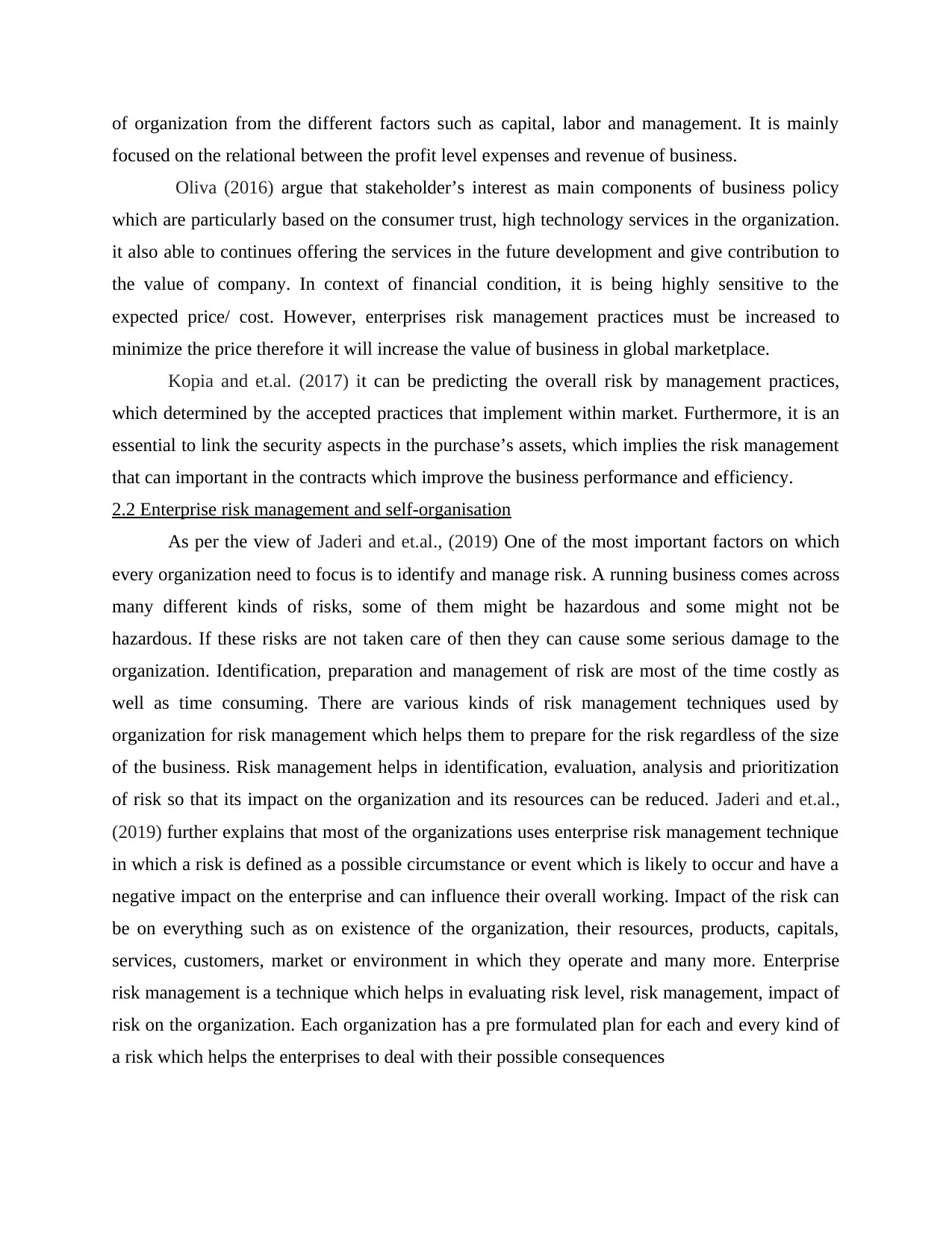
of organization from the different factors such as capital, labor and management. It is mainly
focused on the relational between the profit level expenses and revenue of business.
Oliva (2016) argue that stakeholder’s interest as main components of business policy
which are particularly based on the consumer trust, high technology services in the organization.
it also able to continues offering the services in the future development and give contribution to
the value of company. In context of financial condition, it is being highly sensitive to the
expected price/ cost. However, enterprises risk management practices must be increased to
minimize the price therefore it will increase the value of business in global marketplace.
Kopia and et.al. (2017) it can be predicting the overall risk by management practices,
which determined by the accepted practices that implement within market. Furthermore, it is an
essential to link the security aspects in the purchase’s assets, which implies the risk management
that can important in the contracts which improve the business performance and efficiency.
2.2 Enterprise risk management and self-organisation
As per the view of Jaderi and et.al., (2019) One of the most important factors on which
every organization need to focus is to identify and manage risk. A running business comes across
many different kinds of risks, some of them might be hazardous and some might not be
hazardous. If these risks are not taken care of then they can cause some serious damage to the
organization. Identification, preparation and management of risk are most of the time costly as
well as time consuming. There are various kinds of risk management techniques used by
organization for risk management which helps them to prepare for the risk regardless of the size
of the business. Risk management helps in identification, evaluation, analysis and prioritization
of risk so that its impact on the organization and its resources can be reduced. Jaderi and et.al.,
(2019) further explains that most of the organizations uses enterprise risk management technique
in which a risk is defined as a possible circumstance or event which is likely to occur and have a
negative impact on the enterprise and can influence their overall working. Impact of the risk can
be on everything such as on existence of the organization, their resources, products, capitals,
services, customers, market or environment in which they operate and many more. Enterprise
risk management is a technique which helps in evaluating risk level, risk management, impact of
risk on the organization. Each organization has a pre formulated plan for each and every kind of
a risk which helps the enterprises to deal with their possible consequences
focused on the relational between the profit level expenses and revenue of business.
Oliva (2016) argue that stakeholder’s interest as main components of business policy
which are particularly based on the consumer trust, high technology services in the organization.
it also able to continues offering the services in the future development and give contribution to
the value of company. In context of financial condition, it is being highly sensitive to the
expected price/ cost. However, enterprises risk management practices must be increased to
minimize the price therefore it will increase the value of business in global marketplace.
Kopia and et.al. (2017) it can be predicting the overall risk by management practices,
which determined by the accepted practices that implement within market. Furthermore, it is an
essential to link the security aspects in the purchase’s assets, which implies the risk management
that can important in the contracts which improve the business performance and efficiency.
2.2 Enterprise risk management and self-organisation
As per the view of Jaderi and et.al., (2019) One of the most important factors on which
every organization need to focus is to identify and manage risk. A running business comes across
many different kinds of risks, some of them might be hazardous and some might not be
hazardous. If these risks are not taken care of then they can cause some serious damage to the
organization. Identification, preparation and management of risk are most of the time costly as
well as time consuming. There are various kinds of risk management techniques used by
organization for risk management which helps them to prepare for the risk regardless of the size
of the business. Risk management helps in identification, evaluation, analysis and prioritization
of risk so that its impact on the organization and its resources can be reduced. Jaderi and et.al.,
(2019) further explains that most of the organizations uses enterprise risk management technique
in which a risk is defined as a possible circumstance or event which is likely to occur and have a
negative impact on the enterprise and can influence their overall working. Impact of the risk can
be on everything such as on existence of the organization, their resources, products, capitals,
services, customers, market or environment in which they operate and many more. Enterprise
risk management is a technique which helps in evaluating risk level, risk management, impact of
risk on the organization. Each organization has a pre formulated plan for each and every kind of
a risk which helps the enterprises to deal with their possible consequences
⊘ This is a preview!⊘
Do you want full access?
Subscribe today to unlock all pages.

Trusted by 1+ million students worldwide
1 out of 28
Related Documents
Your All-in-One AI-Powered Toolkit for Academic Success.
+13062052269
info@desklib.com
Available 24*7 on WhatsApp / Email
![[object Object]](/_next/static/media/star-bottom.7253800d.svg)
Unlock your academic potential
Copyright © 2020–2025 A2Z Services. All Rights Reserved. Developed and managed by ZUCOL.





